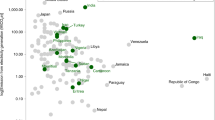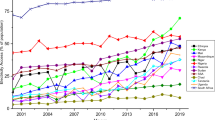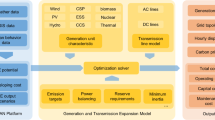Abstract
Many with access to electricity in sub-Saharan Africa (SSA) are subject to frequent outages due to insufficient generation capacities and/or poor transmission and distribution infrastructure. These outages result in increased use of backup diesel generators. We use a Monte Carlo Analysis framework to estimate changes in net air emissions, consumer costs and fossil energy consumption that result from the use of backup diesel generators in SSA. We show that reliance on backup diesel generators can lead to increased air emissions in all countries. Use of backup diesel generators also increases fossil fuel energy consumption by a factor of 1.5–1,000 compared with current grid levels throughout SSA. Finally, we estimate that the costs of generating diesel backup power are millions of dollars higher than the costs of grid electricity in all countries. These results suggest that increasing power system reliability for those with existing electricity access is a key component of meeting sustainable electricity access goals.
This is a preview of subscription content, access via your institution
Access options
Access Nature and 54 other Nature Portfolio journals
Get Nature+, our best-value online-access subscription
$29.99 / 30 days
cancel any time
Subscribe to this journal
Receive 12 digital issues and online access to articles
$119.00 per year
only $9.92 per issue
Buy this article
- Purchase on Springer Link
- Instant access to full article PDF
Prices may be subject to local taxes which are calculated during checkout




Similar content being viewed by others
Data availability
The datasets generated during and/or analysed in the current study are available where cited in the text or from the corresponding author on reasonable request.
References
Transforming our World: the 2030 Agenda for Sustainable Development A/RES/70/1 (UN General Assembly, 2015); http://www.refworld.org/docid/57b6e3e44.html
Africa Energy Outlook—World Energy Outlook Special Report (IEA, 2014).
Brew-Hammond, A. Energy access in Africa: challenges ahead. Energ. Policy 38, 2291 (2010).
Brew-Hammond, A. & Kemausuor, F. Energy for all in Africa—to be or not to be?!. Curr. Opin. Environ. Sustain. 1, 83 (2009).
Eberhard, A., Foster, V. & Briceño, C. Underpowered: the State of the Power Sector in sub-Saharan Africa (2008).
Foster, V. & Steinbuks, J. Paying the Price for Unreliable Power Supplies: In-House Generation of Electricity by Firms in Africa. Working Paper (2009); https://doi.org/10.1596/1813-9450-4913
Gujba, H., Thorne, S., Mulugetta, Y., Rai, K. & Sokona, Y. Financing low carbon energy access in Africa. Energ. Policy 47, 71 (2012).
Szabo, S., Moner-Girona, M., Kougias, I., Bailis, R. & Bodis, K. Identification of advantageous electricity generation options in sub-Saharan Africa integrating existing resources. Nat. Energy 1, 16140 (2016).
Iwayemi, A. Nigeriaas dual energy problems: policy issues and challenges. Int. Assoc. Energy Econ. 53, 17–21 (2008).
Sovacool, B. K., Bazilian, M. & Toman, M. Paradigms and poverty in global energy policy: research needs for achieving universal energy access. Environ. Res. Lett. 11, 064014 (2016).
Alstone, P., Gershenson, D. & Kammen, D. M. Decentralized energy systems for clean electricity access. Nat. Clim. Chang. 5, 305–314 (2015).
Carvallo, J. P., Shaw, B. J., Avila, N. I. & Kammen, D. M. Sustainable low-carbon expansion for the power sector of an emerging economy: the case of Kenya. Environ. Sci. Technol. 51, 10232–10242 (2017).
Mentis, D. et al. Lighting the world: the first application of an open source, spatial electrification tool (OnSSET) on sub-Saharan Africa. Environ. Res. Lett. 12, 085003 (2017).
Moksnes, N., Korkovelos, A., Mentis, D. & Howells, M. Electrification pathways for Kenya—linking spatial electrification analysis and medium to long term energy planning. Environ. Res. Lett. 12, 095008 (2017).
Fioriti, D. et al. Stochastic sizing of isolated rural mini-grids, including effects of fuel procurement and operational strategies. Electr. Pow. Syst. Res. 160, 419–428 (2018).
Ohiare, S. Expanding electricity access to all in Nigeria: a spatial planning and cost analysis. Energy Sustain. Soc. 5, 8 (2015).
Bhatia, M. & Angelou, N. Beyond Connections: Energy Access Redefined (2015).
Pelz, S., Pachauri, S. & Groh, S. A critical review of modern approaches for multidimensional energy poverty measurement. WIREs Energy Environ. https://doi.org/10.1002/wene.304 (2018).
Bazilian, M. et al. Energy access scenarios to 2030 for the power sector in sub-Saharan Africa. Util. Policy 20, 1 (2012).
Enterprise Surveys (World Bank, 2016); http://www.enterprisesurveys.org
Eberhard, A., Rosnes, O., Shkaratan, M. & Vennemo, H. Africa’s Power Infrastructure (World Bank, 2011); https://doi.org/10.1596/978-0-8213-8455-8
Marais, E. A. & Wiedinmyer, C. Air quality impact of diffuse and inefficient combustion emissions in Africa (DICE-Africa). Environ. Sci. Technol. 50, 10739–10745 2016).
Oseni, M. O. Power outages and the costs of unsupplied electricity: evidence from backup generation among firms in Africa. PhD Thesis, Cambridge Univ. (2012).
Sovacool, B. K. The political economy of energy poverty: a review of key challenges. Energy Sustain. Dev. 16, 272–282 (2012).
Pronk, A., Coble, J. & Stewart, P. Occupational exposure to diesel engine exhaust: a literature review. J. Exp. Sci. Env. Epid. 19, 443 (2009).
McDonald, J. D. et al. Engine-operating load influences diesel exhaust composition and cardiopulmonary and immune responses. Environ. Health Persp. 119, 1136 (2011).
Gilmore, E. A., Adams, P. J. & Lave, P. J. Using backup generators for meeting peak electricity demand: a sensitivity analysis on emission controls, location, and health endpoints. J. Air Waste Manage. 60, 523 (2010).
Health Assessment Document for Diesel Engine Exhaust (EPA, 2002).
Heft-Neal, S., Burney, J., Bendavid, E. & Burke, M. Robust relationship between air quality and infant mortality in Africa. Nature 559, 254–258 (2018).
Air Pollution Levels Rising in Many of the World’s Poorest Cities (World Health Organization, 2016).
Awofeso, N. Generator diesel exhaust: a major hazard to health and the environment in Nigeria. Am. J. Respir. Crit. Care Med. 183, 1437 (2011).
Oguntoke, O. & Adeyemi, A. Degradation of urban environment and human health by emissions from fossil-fuel combusting electricity generators in Abeokuta metropolis, Nigeria. Indoor Built Environ., https://doi.org/10.1177/1420326x16629818 (2016).
Air Pollutant Emission Inventory Guidebook 2016 (EMEP/EEA, 2016).
IPCC Guidelines for National Greenhouse Gas Inventories (Intergovernmental Panel on Climate Change, 2006).
Tong, D. et al. Targeted emission reductions from global super-polluting power plant units. Nat. Sustain. 1, 59 (2018).
NDC Platform (World Bank, 2017); http://spappssecext.worldbank.org/sites/indc/Pages/INDCHome.aspx
World Development Indicators 2016 (World Bank, 2016).
CO 2 Emissions from Fuel Combustion-Highlights (IEA Statistics, 2017).
IEA Statistics (International Energy Agency, 2016).
Gasoline and Diesel Industrial Engines AP-42, Vol. I, 3.3 (EPA, 1998).
Standardized Baseline Assessment for Rural Off-Grid-Electrification in sub-Saharan Africa (UNDP, 2013).
Jabeck, B. The Impact of Generator Set Underloading (2014).
Hofstrand, D. Liquid Fuel Measurements and Conversions (2008).
Trimble, C., Kojima, M., Arroyo, I. P. & Mohammadzadeh, F. Financial Viability of Electricity Sectors in sub-Saharan Africa: Quasi-Fiscal Deficits and Hidden Costs (World Bank, 2016).
Rapid Assessment Gap Analysis: Angola (Sustainable Energy for All, 2015).
Acknowledgements
Correspondence and requests should be addressed to D. F. Funding for this work came from the Department of Engineering and Public Policy at Carnegie Mellon University. The Bill and Melinda Gates Foundation also provided support for this work through the Gates Millennium Scholars Program. The conclusions and recommendations in this article are the sole responsibility of the authors and may not represent the opinions of the funding sources.
Author information
Authors and Affiliations
Contributions
D.F. conducted principal analysis, interpretation of data and drafting of the manuscript. P.J. led design and conceptualization efforts of the research and collaborated in drafting the manuscript and subsequent revisions. C.S. helped in the design and conceptualization efforts of the research and collaborated in drafting the manuscript and subsequent revisions.
Corresponding author
Ethics declarations
Competing interests
The authors declare no competing interests.
Additional information
Publisher’s note: Springer Nature remains neutral with regard to jurisdictional claims in published maps and institutional affiliations.
Supplementary information
Supplementary Information
Supplementary Figures 1–3, Supplementary Tables 1–10, Supplementary Methods, Supplementary References 1–15
Rights and permissions
About this article
Cite this article
Farquharson, D., Jaramillo, P. & Samaras, C. Sustainability implications of electricity outages in sub-Saharan Africa. Nat Sustain 1, 589–597 (2018). https://doi.org/10.1038/s41893-018-0151-8
Received:
Accepted:
Published:
Issue Date:
DOI: https://doi.org/10.1038/s41893-018-0151-8
This article is cited by
-
Photovoltaic waste management in sub-Saharan Africa: current practices in Burkina Faso
Waste Disposal & Sustainable Energy (2024)
-
Geospatial mapping of distribution grid with machine learning and publicly-accessible multi-modal data
Nature Communications (2023)
-
Financial sustainability disparities among energy distribution companies: a multi-factor study case in Brazil
SN Business & Economics (2023)
-
Evolution of laparoscopic surgery in a sub-Saharan African country: a 30-year literature review in Senegal
Surgical Endoscopy (2023)
-
Factors associated with conversion in laparoscopic surgery in a low-resource setting: a single-center prospective study
Surgical Endoscopy (2023)



